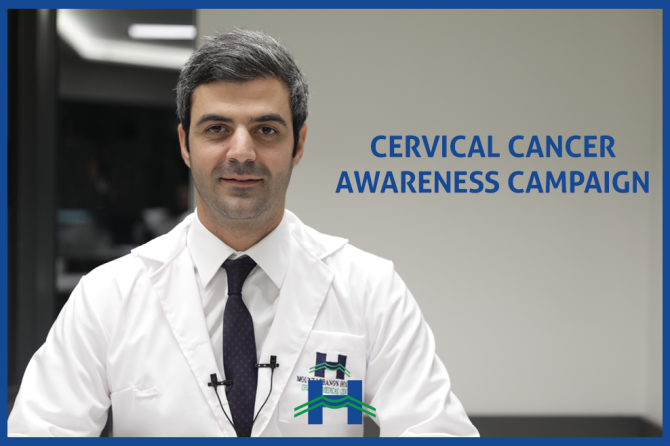
Cervical Cancer Awareness
What is Cervical Cancer?
Cervical Cancer is the third most common Gynecologic Cancer after Endometrial and Ovarian Cancers. It affects 1 in 60 woman and is responsible for 266 thousand death worldwide every year.
There are three ways to prevent Cervical Cancer:
Primary prevention:
- HPV vaccination
Secondary prevention:
- Pap test screening, starting age 21
- HPV test
What causes cervical cancer?
Cervical Cancer is caused by the Human Papilloma Virus (HPV) and can be transmitted between individuals by sexual contact. 75% to 80% of sexually active adults will acquire HPV before the age of 50. Most people that acquire HPV will self-clear in a period of 12 months, however some individuals will have persistent HPV that can lead to cancer and/or genital warts.
There are more than 100 types of HPV. Fifteen of them were classified as high risk (HPV 16, 18, 31, 33, 35, 39, 45, 51, 52, 56, 58, 59, 68, 73, and 82) and about 40 kinds can infect the genital area including vulva, vagina, cervix, rectum, anus, penis, scrotum as well as other areas such as the mouth, throat and skin. These kinds of HPV are spread during all forms of sexual contact.
How is HPV transmitted?
HPV is easily spread through skin-to-skin or sexual contact with someone who is already infected. Both males and females can transmit the virus during sex when the vulva, vagina, cervix, anus, penis or skin touches someone else’s genitals, mouth, throat or skin. HPV can be spread even if there was no ejaculation, and even if there was no of the penis inside the vagina, anus or mouth.
What are the symptoms of HPV infection?
Most people with HPV don’t present any warning signs, symptoms or health problems. Some types of HPV can cause genital warts; other high-risk types can cause cancer. Unfortunately, most people who have acquired a high-risk type of HPV will never show any signs of the infection until abnormalities are detected on Pap test, or until the appearance of warts or cervical cancer.
If HPV develops into cancer, symptoms may vary as the following:
- Penile cancer, known as cancer of the penis, might show symptoms like changes in the penis’ skin color, thickness, or a painful sore.
- Anal cancer might cause anal bleeding, pain, itching, discharge, or changes in bowel habits.
- Vulvar cancer, known as cancer of the vulva, might show symptoms like changes in the vulva’s skin color or thickness. The patient might experience chronic pain, itching, or find a lump.
- Throat cancer might cause a sore throat, ongoing ear pain, constant coughing, pain or trouble swallowing or breathing, weight loss, a lump or mass in the neck.
How to screen for cervical cancer?
The physician will recommend the relevant tests when needed and the frequency at which they should be repeated. There are two ways of screening for cervical cancer:
- Pap test (Pap smear) is when the physician collects cells from the patient’s cervix for pathological evaluation.
- HPV test can be done at certain occasions depending on the patient’s age.
Both tests can be done at the doctor’s clinic. If any abnormality is detected on the patient’s Pap test, the doctor might recommend different ways to go about it depending on the cytology.
- Repeat the tests after 6 months or a year.
- Colposcopy
- LEEP Procedure
Colposcopy is when the doctor checks the cervix using an instrument called the colposcope; a sophisticated binocular. If the doctor sees any abnormality, he usually recommends a biopsy. Colposcopy is safe, quick and done in the doctor’s clinic, it doesn’t affect the patient’s ability to have children nor complicates future pregnancies. This procedure is painless and safe during pregnancy.
LEEP (Loop Electrosurgical Excision Procedure) is when the doctor uses a thin wire loop to remove a cone shaped portion of the cervix. Excision can be done in the clinic or in the operating room. This procedure is done under local anesthetic and Vasoconstrictor Solution or a topical anesthetic spray, therefore the patient should not feel any pain during the process.
How is transmission of HPV virus prevented?
The best way to limit the transmission of HPV between individuals is by vaccination before onset of sexual intercourse. Both females and males should be vaccinated. Another way to lower the chances of disease spread during sexual encounters is by using condoms while having vaginal, anal, or oral sex. Although less effective than HPV vaccination, safe sex lowers the chances of transmitting HPV.
What is the HPV vaccine?
HPV vaccine can prevent 90 % of HPV related cancers and diseases. It is given in two or three doses starting age 9 up until age 45, by intramuscular injection. This vaccine is best given before the start of sexual activity (exposure to HPV). There are three types of HPV vaccines available and they differ by the number of strains of HPV they protect against.
- Cervarix: protects against cervical cancer only, by targeting HPV types 16 and 18.
- Gardasil 4 protects against cervical cancer and genital warts by targeting HPV types 6, 11, 16 and 18.
- Gardasil 9 protects against cervical cancer and genital warts by targeting HPV types 6, 11, 16, 18, 31, 33, 45, 52 and 58.
HPV vaccine is an inactive vaccine and has a good safety profile. Most common reported side effects include: local irritation at vaccination site, headache, and fever.
It’s recommended that children get the vaccine at age 11 or 12, so they’re fully protected years before they become sexually active.
Dr. Elias Abi Khalil,
American Board of Obstetrics and Gynecology
Minimally invasive Gynecologic surgery
For more information and to book an appointment call +9615957000-1500
Follow us on :
https://www.facebook.com/mountlebanonhospital
https://www.instagram.com/mountlebanonhospital
Leave a reply







